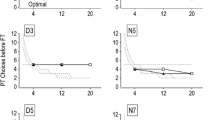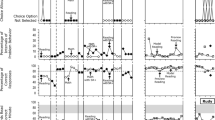Abstract
This study evaluated the effects of four instructional variants on instruction following under changing reinforcement schedules using an operant task based on Hackenberg and Joker’s Journal of the Experimental Analysis of Behavior, 62, 367–383 (1994) experimental preparation. Sixteen college-aged adults served as participants and were randomly assigned to one of four instruction conditions (directive, generic, non-directive, and control). Results suggest textual verbal behavior modulated instruction following. Specifically, directive and generic instructions produced greater levels of instructional control and relatively lower levels of schedule control compared to non-directive instructions. Thus, participants in the directive and generic groups responded in accordance with the instructions even when schedules of reinforcement favored deviation from the instructed pattern. In contrast, participants in the non-directive group responded toward the optimal pattern. In the control condition, participant responding was variable but toward the optimal pattern. Findings are interpreted within the framework of Skinner’s analysis of verbal behavior and formulation of rule governance.



Similar content being viewed by others
Notes
We use the term “instructions” here and throughout the manuscript consistent with cited authors’ terminology, which may or may not describe antecedent manipulations that provide incomplete contingency specification. Note Skinner’s formal definition of rules includes accurate specification of all three terms in the three-term operant contingency.
We use the term “session” in the instructions to refer to a 15-min block, which should not be confused with the same term used in the description of the experimental preparation. We retained this phrasing to be consistent with Hackenberg and Joker (1994) and Miller et al. (2014) and enhance participant understanding
Different sequences of responses on the red and blue squares influenced point delivery/accumulation. Based on our calculations, two optimal switch points maximized point delivery for PT 12. Other PT schedule values had only one optimal switch point.
References
Baron, A., & Galizio, M. (1983). Instructional control of human operant behavior. The Psychological Record, 33, 495–520.
Baron, A., Kaufman, A., & Stauber, K. A. (1969). Effects of instructions and reinforcement-feedback on human operant behavior maintained by fixed-interval reinforcement. Journal of the Experimental Analysis of Behavior, 12, 701–712. doi:10.1901/jeab.1969.12-701.
Baumann, A. A., Abreu-Rodrigues, J., & da Silva Souza, A. (2009). Rules and self-rules: effects of variation upon behavioral sensitivity to change. The Psychological Record, 59, 641–670.
Bicard, D. E., & Neef, N. A. (2002). Effects of strategic versus tactical instructions on adaptation to changing contingencies in children with ADHD. Journal of Applied Behavior Analysis, 35, 375–389. doi:10.1901/jaba.2002.35-375.
Danforth, J. S., Chase, P. N., Dolan, M., & Joyce, J. H. (1990). The establishment of stimulus control by instructions and by differential reinforcement. Journal of the Experimental Analysis of Behavior, 54, 97–112. doi:10.1901/jeab.1990.54-97.
DeGrandpre, R. J., & Buskist, W. (1991). Effects of accuracy of instructions on human behavior: correspondence with reinforcement contingencies matters. The Psychological Record, 41, 371–384.
Fox, A. E., & Pietras, C. J. (2013). The effects of response-cost punishment on instructional control during a choice task. Journal of the Experimental Analysis of Behavior, 99, 346–361. doi:10.1002/jeab.20.
Galizio, M. (1979). Contingency-shaped and rule-governed behavior: instructional control of human loss avoidance. Journal of the Experimental Analysis of Behavior, 31, 53–70. doi:10.1901/jeab.1979.31-53.
Glenn, S. S. (1987). Rules as environmental events. The Analysis of Verbal Behavior, 5, 29–32.
Hackenberg, T. D., & Joker, V. R. (1994). Instructional versus schedule control of humans’ choices in situations of diminishing returns. Journal of the Experimental Analysis of Behavior, 62, 367–383. doi:10.1901/jeab.1994.62-367.
Hayes, S. C. (1993). Rule governance: basic behavioral research and applied applications. Current Directions in Psychological Science, 2, 193–197. doi:10.1111/1467-8721.ep10769746.
Hayes, S. C., Brownstein, A. J., Haas, J. R., & Greenway, D. E. (1986a). Instructions, multiple schedules, and extinction: distinguishing rule-governed from schedule-controlled behavior. Journal of the Experimental Analysis of Behavior, 46, 137–147. doi:10.1901/jeab.1986.46-137.
Hayes, S. C., Brownstein, A. J., Zettle, R. D., Rosenfarb, I., & Korn, Z. (1986b). Rule-governed behavior and sensitivity to changing consequences of responding. Journal of the Experimental Analysis of Behavior, 45, 237–256. doi:10.1901/jeab.1986.45-237.
Joyce, J. H., & Chase, P. N. (1990). Effects of response sensitivity of rule-governed behavior. Journal of the Experimental Analysis of Behavior, 54, 251–262. doi:10.1901/jeab.1990.54-251.
Miller, J. R., Hirst, J. M., Kaplan, B. A., DiGennaro Reed, F. D., & Reed, D. D. (2014). Effects of mands on instructional control: a laboratory simulation. The Analysis of Verbal Behavior, 30, 100–112. doi:10.1007/s40616-014-0015-x.
Mistr, K. N., & Glenn, S. S. (1992). Evocative and function-altering effects of contingency-specifying stimuli. The Analysis of Verbal Behavior, 10, 11–21.
Okouchi, H. (1999). Instructions as discriminative stimuli. Journal of the Experimental Analysis of Behavior, 72, 205–214. doi:10.1901/jeab.1999.72-205.
Perepletchikova, F., Hilt, L. M., Chereji, E., & Kazdin, A. E. (2009). Barriers to implementing treatment integrity procedures: survey of treatment outcome researchers. Journal of Consulting and Clinical Psychology, 77, 212–218. doi:10.1037/a0015232.
Podlesnik, C. A., & Chase, P. N. (2006). Sensitivity and strength: effects of instructions on resistance to change. The Psychological Record, 56, 303–320.
Schlinger, H., & Blakely, E. (1987). Function-altering effects of contingency-specifying stimuli. The Behavior Analyst, 10, 41–45.
Shimoff, E., Catania, A. C., & Matthews, B. A. (1981). Uninstructed human responding: sensitivity of low-rate performance to schedule contingencies. Journal of the Experimental Analysis of Behavior, 36, 207–220. doi:10.1901/jeab.1981.36-207.
Shimoff, E., Matthews, B. A., & Catania, A. C. (1986). Human operant performance: sensitivity and pseudosensitivity to contingencies. Journal of the Experimental Analysis of Behavior, 46, 149–157. doi:10.1901/jeab.1986.46-149.
Skinner, B. F. (1966). What is the experimental analysis of behavior? Journal of the Experimental Analysis of Behavior, 9, 213–218. doi:10.1901/jeab.1966.9-213.
Skinner, B. F. (1969). Contingencies of reinforcement: a theoretical analysis. New York, NY: Appleton-Century-Crofts.
Skinner, B. F. (1974). About behaviorism. New York, NY: Knopf.
Vaughan, M. E. (1985). Repeated acquisition in the analysis of rule-governed behavior. Journal of the Experimental Analysis of Behavior, 44, 175–184. doi:10.1901/jeab.1985.44-175.
Vollmer, T. R., Sloman, K. N., & St. Peter Pipkin, C. (2008). Practical implications of data reliability and treatment integrity monitoring. Behavior Analysis in Practice, 1(2), 4–11.
Zettle, R. D., & Hayes, S. C. (1982). Rule-governed behavior: a potential theoretical framework for cognitive-behavioral therapy. In P. C. Kendall (Ed.), Advances in cognitive-behavioral research and therapy (Vol. 1, pp. 73–118). New York: Academic.
Zettle, R. D., & Young, M. J. (1987). Rule-following and human operant responding: conceptual and methodological considerations. The Analysis of Verbal Behavior, 5, 33–39.
Author information
Authors and Affiliations
Corresponding author
Ethics declarations
Funding
This investigation was supported by the New Faculty Research Grant at the university affiliation for the third author; allocation #2302290.
Conflict of interest
The authors declare that they have no conflict of interest.
Informed consent
Informed consent was obtained from all individual participants included in this study.
Ethical approval
All procedures performed in studies involving human participants were in accordance with the ethical standards of the institutional and/or national research committee and with the 1964 Helsinki declaration and its later amendments or comparable ethical standards.
Rights and permissions
About this article
Cite this article
Henley, A.J., Hirst, J.M., DiGennaro Reed, F.D. et al. Function-Altering Effects of Rule Phrasing in the Modulation of Instructional Control. Analysis Verbal Behav 33, 24–40 (2017). https://doi.org/10.1007/s40616-016-0063-5
Published:
Issue Date:
DOI: https://doi.org/10.1007/s40616-016-0063-5




